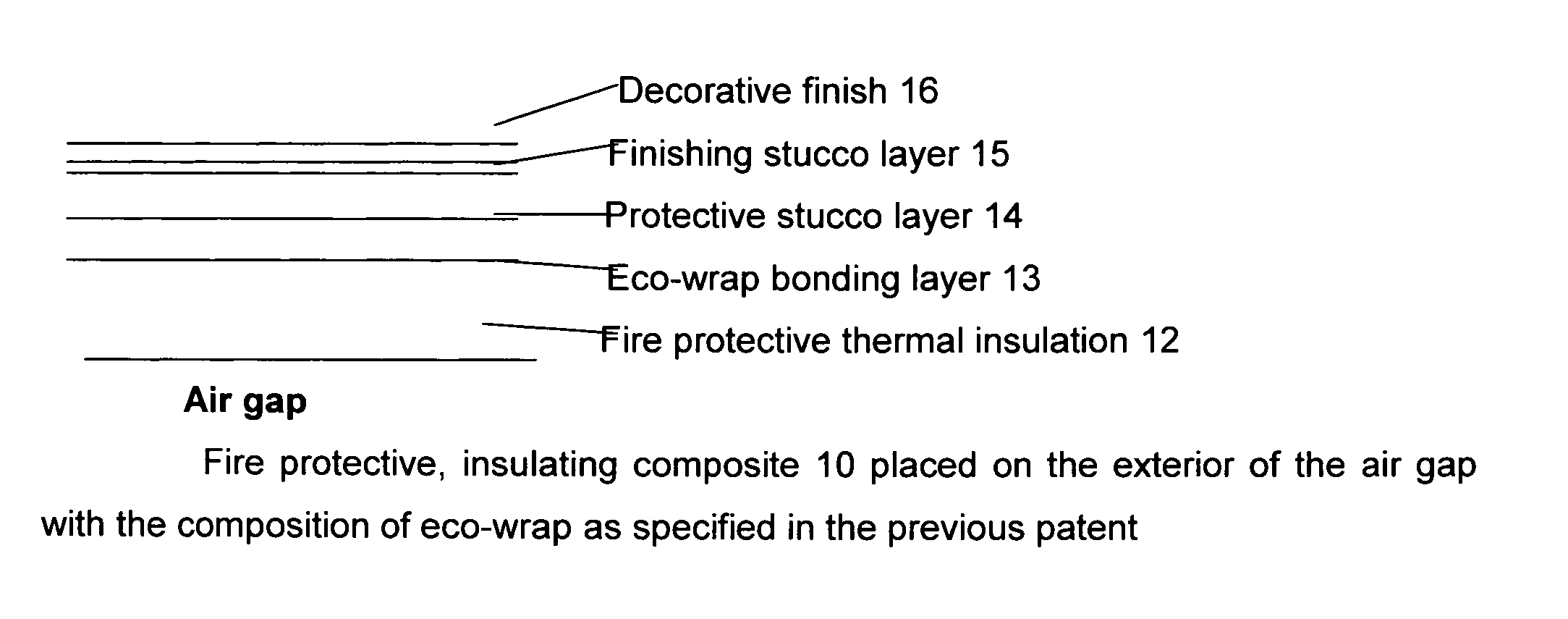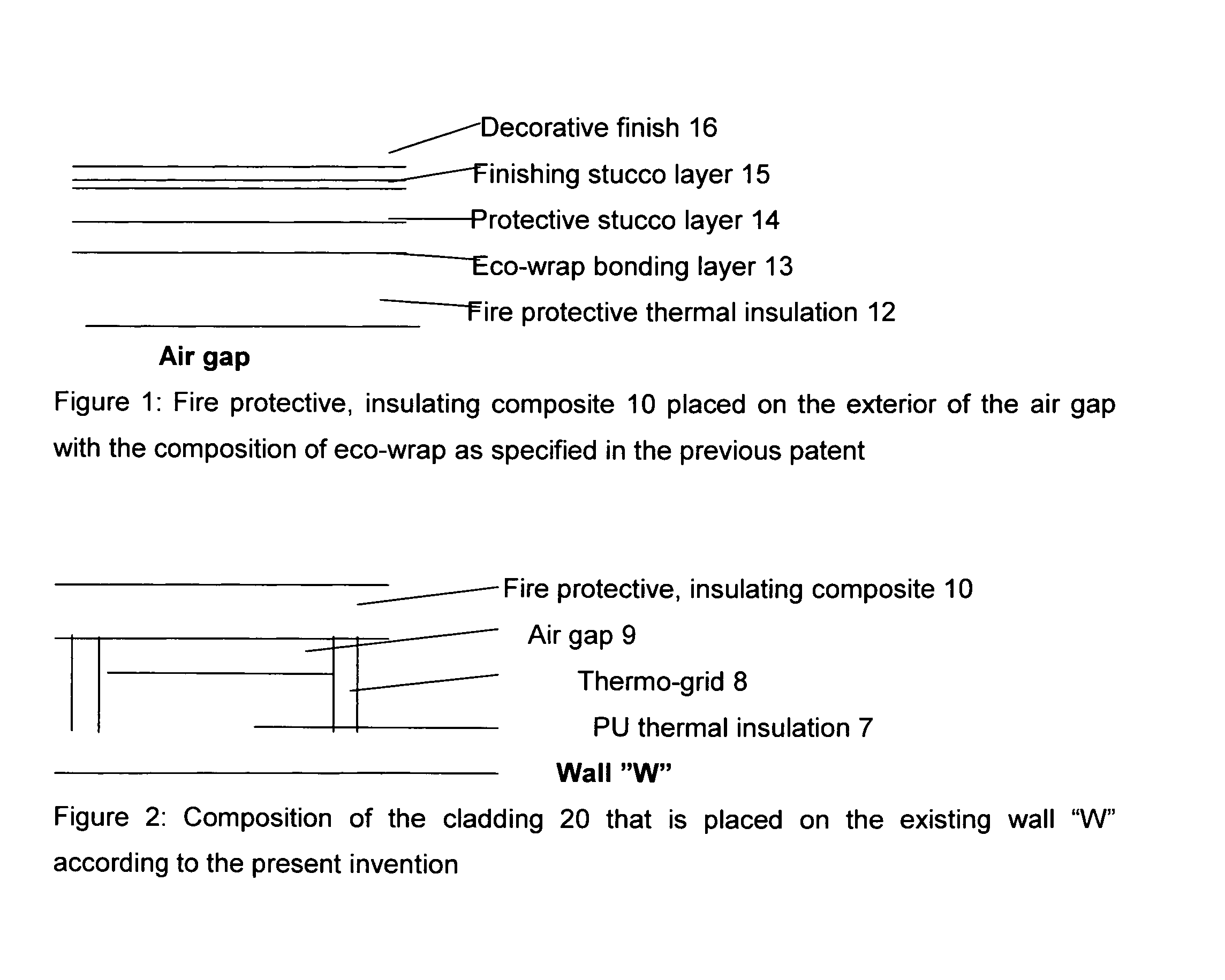Continuous thermal insulation and fire protective composite placed on thermo-grid designed for wind load transfer
a composite and thermal insulation technology, applied in the field of construction materials, can solve the problems of affecting the degree of fire protection, the cracking of the outer surface layer of the material, and the cracking of the 3-coat portland cement plaster, etc., and achieves the effect of easy modification, easy application, and even exterior surfa
- Summary
- Abstract
- Description
- Claims
- Application Information
AI Technical Summary
Benefits of technology
Problems solved by technology
Method used
Image
Examples
example 1
An External Insulation System for Cold Climate
[0042]Since 1994 flexible and rigid wood-fiber insulation boards have been produced in Germany in accordance with a standard WF-EN 13171-T3-CS (10 / Y) 20-TR7, 5-WS2, 0-MU5-AF100. When a multi-fiber system is used as an additive to the wood fibers to modify its physical properties this product is known as “Eco-fiber board”. The material came from Homatherm GmbH in Berga, Germany. It has density about 140 kg / m3, a thermal conductivity measured at 10° C. equal to 0.037 W / mK or thermal resistivity of 3.75 (of hr ft2) / BTU in, specific heat 2100 J / (kgK) and thickness 40 mm (1⅝ inch). It was mechanically fastened to thermo-grid using epoxy covered screws and plastic washers The HT wrap (the layers 13 and 14) was from a pilot production of Sto Corp with the mix was designed in accordance with this invention. Glass fiber mesh (5 oz) was placed between the layers 13 and 14. The layer 15 was a StoSilco®Lastic—a ready-mixed, silicone-enhanced, smooth...
example 2
External Insulation System for Warm Climate
[0043]There was no air gap in is example but a poured close cell polyurethane foam was applied with 2 ft increments between thermo-grid placed on each stud and serving as locations of the mechanical fasteners for the protective composite. In the actual example foams from two different manufacturers were used. One of the foams had CCMC 12840-Report that describes the technical features as follows: The final cured product has a nominal density of 30.4 kg / m3 and an assigned design thermal resistance of 1.05 m2·° C. / W per 25 mm (R6 per inch). Compressive strength is 222 kPa and tensile strength 337 kPa that is sufficient to ensure adhesion to the substrate and cohesion of the foam.
[0044]In this example, the HT wrap had additional admixture of layered silica to reduce its WVT and the finishing layer applied on an HT-wrap was acrylic coating with permeance below 1 perm.
Notes on the Examples of this Invention
[0045]This system has several options t...
PUM
| Property | Measurement | Unit |
|---|---|---|
| Permeability | aaaaa | aaaaa |
| Thermal properties | aaaaa | aaaaa |
Abstract
Description
Claims
Application Information
 Login to View More
Login to View More - R&D
- Intellectual Property
- Life Sciences
- Materials
- Tech Scout
- Unparalleled Data Quality
- Higher Quality Content
- 60% Fewer Hallucinations
Browse by: Latest US Patents, China's latest patents, Technical Efficacy Thesaurus, Application Domain, Technology Topic, Popular Technical Reports.
© 2025 PatSnap. All rights reserved.Legal|Privacy policy|Modern Slavery Act Transparency Statement|Sitemap|About US| Contact US: help@patsnap.com


